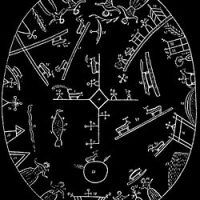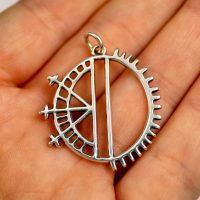Beaivi : The Sun Goddess
Listen
At a glance
| Description | |
|---|---|
| Origin | Sami Mythology |
| Classification | Gods |
| Family Members | Beaivi-nieida (Daughter) |
| Region | Norway, Sweden |
| Associated With | Sun, Fertility |
Beaivi
Introduction
Beaivi, also spelled Beiwe, Bievve, Beivve, or Biejje, is one of the most revered deities in Sámi mythology. The Sámi, an Indigenous people of northern Norway, Sweden, Finland, and Russia’s Kola Peninsula, have lived for centuries in close connection with the Arctic’s harsh environment. In this frozen land, where the sun disappears for months during the polar winter, Beaivi represents light, warmth, fertility, and life itself. She is the solar goddess whose annual return heralds the end of darkness and the rebirth of the world. The Sámi believe Beaivi’s energy governs both the physical and spiritual well-being of humans, animals, and nature. More than just a solar figure, she embodies the balance between survival and renewal, making her a central presence in Sámi cosmology.
Physical Traits
Beaivi is typically imagined as a radiant female figure glowing with the brilliance of the Arctic sun. Although traditional Sámi mythology is oral and rarely visualized through fixed imagery, she is often described as having golden hair that shines like sunlight and a luminous face symbolizing warmth and fertility. Some tales describe her traveling across the sky in a chariot drawn by reindeer, connecting her directly to one of the Sámi’s most sacred animals. Reindeer antlers are symbolic of her vitality and cyclic power, often represented in rituals and drum art. Her daughter, Beaivi-nieida, sometimes accompanies her, enclosed in a circular or antler-like frame that represents the returning sunlight of spring. The visual imagery of Beaivi blends the physical sun with the spiritual essence of life, radiating warmth after the cold desolation of winter.
Family
Beaivi’s mythological family reflects the interconnected nature of Sámi beliefs about the cosmos. Her most prominent kin is her daughter, Beaivi-nieida—the Sun Maiden—who symbolizes the youthful renewal of spring. Together, they journey across the sky to restore fertility and vitality to the frozen earth. Some Sámi traditions mention additional figures associated with Beaivi, such as celestial siblings or family members dwelling in golden or fiery homes, each representing natural elements like warmth, vegetation, or seasonal light. In certain Eastern Sámi narratives, Beaivi is described as the mother of Peivalke, a solar son who competes with the northern lights for the love of the moon’s daughter, illustrating the natural tension between day, night, and celestial forces. These familial stories give the Sámi sun deity a richly symbolic household representing the natural rhythms of the polar world.
Other names
Across the vast region of Sápmi, Beaivi is known by multiple names that vary according to dialect and geography. In Northern Sámi, she is called Bievve or Beivve; in Lule Sámi, Biejje; and in Inari Sámi, Piäiváž. Regardless of the variation, each name originates from the Sámi word for “sun.” Her daughter, Beaivi-nieida, is also known by names such as Sala-nieida, Akanidi, or Rananieida in different local traditions. These variations highlight how deeply integrated Beaivi’s worship is within regional linguistic and cultural expressions, reflecting the decentralized but enduring nature of Sámi spirituality.
Powers and Abilities
Beaivi’s powers encompass the full spectrum of life-giving energy, both physical and spiritual. As the goddess of the sun, she governs the return of light after the long polar night, melting snow and reviving vegetation. Her warmth awakens the frozen earth, allowing plants to grow and reindeer to thrive—two vital elements of the Sámi way of life. As a fertility goddess, Beaivi ensures reproduction among animals and humans, sustaining the cycles of abundance that define the Arctic seasons.
Beyond her role as a provider of light and fertility, Beaivi also presides over mental health and emotional balance. The Sámi observed that prolonged darkness often led to despair and psychological distress, so Beaivi’s return was viewed as a restoration of sanity and spiritual clarity. Rituals invoking Beaivi for the mentally ill were common, particularly during midwinter when sunlight was scarce. Offerings were made to her, such as butter smeared on doorposts or special cakes made with reindeer blood, to strengthen her for her journey through the sky.
Beaivi’s influence extends to protection and guidance. Her light was believed to help travelers and herders navigate safely through blizzards and darkness. In every form, her power symbolizes renewal, healing, and harmony—fundamental themes in Sámi cosmology and survival.
Modern Day Influence
Although Christianization in the 17th and 18th centuries suppressed many aspects of Sámi spirituality, Beaivi’s legacy continues to illuminate modern Sámi identity. Her image and symbolism persist through cultural festivals, art, and literature that celebrate Indigenous resilience and environmental reverence. During the winter solstice, some Sámi communities still observe rituals inspired by Beaivi worship, offering butter or food to mark the sun’s slow return.
Beaivi also serves as a modern emblem of ecological awareness. In contemporary art and activism, she embodies harmony between humanity and nature, symbolizing the delicate balance necessary to preserve Arctic ecosystems threatened by climate change. Her presence in Sámi drum designs, paintings, and traditional clothing has evolved into a symbol of cultural pride and continuity.
In psychology and wellness discussions, Beaivi’s link to mental health resonates deeply, especially for those living in extreme northern environments where seasonal affective disorder is common. Her role as the restorer of light has inspired mental health campaigns emphasizing natural cycles and self-care during winter months.
Feminist movements within Indigenous circles have also reinterpreted Beaivi as a figure of empowerment. Her nurturing yet commanding nature represents the strength of women as life-givers and healers, bridging ancient mythology with modern gender symbolism. Beaivi stands as both a spiritual and cultural icon—her light no longer confined to the Arctic sky but radiating through global awareness of Indigenous wisdom and sustainability.
Related Images
Source
Beaivi Facts for Kids. (n.d.). Kiddle encyclopedia. Retrieved November 5, 2025, from https://kids.kiddle.co/Beaivi
Snowchange Cooperative. (n.d.). Snowscapes: Beaivi, the sun spirit. Retrieved November 5, 2025, from http://www.snowchange.org/pages/wp-content/uploads/2014/08/pages-223-423.pdf
Unveiling the Tales of Ancient Sami Deities – Old World Gods. (2024, April 13). Retrieved November 5, 2025, from https://oldworldgods.com/other/sami-mythology-gods-and-goddesses/
Beaivi. (2010, September 25). In Wikipedia. Retrieved November 5, 2025, from https://en.wikipedia.org/wiki/Beaivi
Beaivi – Simple English Wikipedia, the free encyclopedia. (2013, February 21). Retrieved November 5, 2025, from https://simple.wikipedia.org/wiki/Beaivi
Religion – The Sami. (2025, November 2). Minnesota Historical Society. Retrieved November 5, 2025, from https://www.mpm.edu/research-collections/anthropology/online-collections-research/sami/religion
The Sacred Bear in Sámi mythology – Ask The Mountains. (2025, July 26). Retrieved November 5, 2025, from https://ask-the-mountains.com/2025/07/27/the-sacred-bear-in-sami-mythology/
Pentikäinen, J. (1996). Saami Shamanism and Arctic Nature Religion. Helsinki: Finnish Literature Society.
Hultkrantz, Å. (1985). The Religion of the Sami: A Historical Account. In T. Ahlbäck (Ed.), Saami Religion (pp. 15–34). Åbo Akademi.
Rydving, H. (1993). The End of Drum-Time: Religious Change among the Lule Saami, 1670s–1740s. Uppsala University.
Lehtola, V.-P. (2004). The Sámi People: Traditions in Transition. University of Alaska Press.
Pulkkinen, R. (2005). Sámi Mythology and Folklore. In Encyclopedia of Religion (2nd ed., Vol. 12, pp. 8182–8186). Macmillan Reference.
Nickul, K. (1977). The Lappish Nation: Citizens of Four Countries. Indiana University Press.
Frequently Asked Questions
What is lorem Ipsum?
I am text block. Click edit button to change this text. Lorem ipsum dolor sit amet, consectetur adipiscing elit. Ut elit tellus, luctus nec ullamcorper mattis, pulvinar dapibus leo.
What is lorem Ipsum?
I am text block. Click edit button to change this text. Lorem ipsum dolor sit amet, consectetur adipiscing elit. Ut elit tellus, luctus nec ullamcorper mattis, pulvinar dapibus leo.
What is lorem Ipsum?
I am text block. Click edit button to change this text. Lorem ipsum dolor sit amet, consectetur adipiscing elit. Ut elit tellus, luctus nec ullamcorper mattis, pulvinar dapibus leo.
What is lorem Ipsum?
I am text block. Click edit button to change this text. Lorem ipsum dolor sit amet, consectetur adipiscing elit. Ut elit tellus, luctus nec ullamcorper mattis, pulvinar dapibus leo.
What is lorem Ipsum?
I am text block. Click edit button to change this text. Lorem ipsum dolor sit amet, consectetur adipiscing elit. Ut elit tellus, luctus nec ullamcorper mattis, pulvinar dapibus leo.








